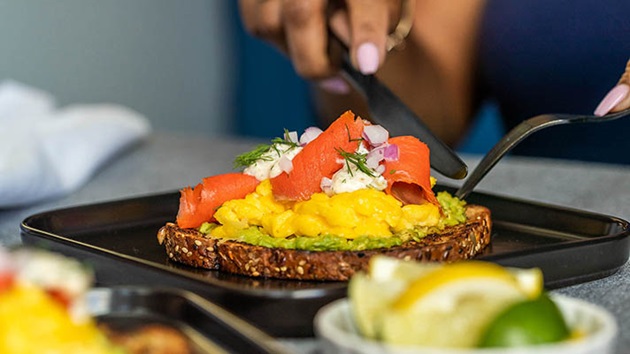It has an exquisite taste, is versatile and not as tricky to cook as you might think...with more sustainable varieties available than ever, crab is scuttling back into the limelight.
The global love of crab
Every corner of the world seems to have its own crab dish. It is eaten in tacos and empanadas in Central and South America (with red bell peppers, minced jalapenos and garlic), in maki rolls as sushi in Japan (with spicy mayonnaise, avocado and dried seaweed) and in pasta dishes in Europe (with anything from chilli and lemon linguine to an indulgent crab mac and cheese).
But if it’s being so widely consumed, how sustainable is crab?
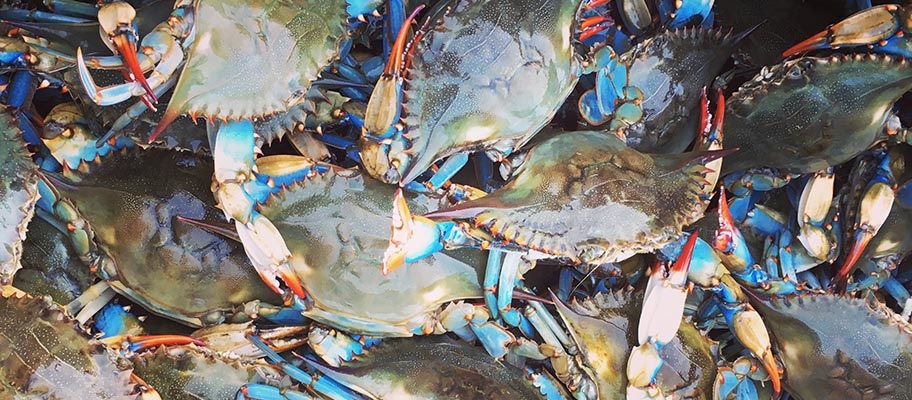
Louisiana blue crab © David Loftus for MSC
Sustainable crab fisheries
Thankfully there are a healthy variety of different crabs available from sustainable fisheries around the world. As of September 2021, there are 10 MSC certified crab fisheries, from Shetland in Scotland (brown crab) to Australia (crystal crab and blue swimmer crab), Canada (snow crab) to the Gulf of Mexico (blue crab) and the Barents Sea in Russia (opilio and red king crab).
Brown crabs (often known as edible crabs) make up the largest crab fishery in Western Europe, with more than 60,000 tonnes caught annually, mostly around the coast of the British Isles.
Because crabs are such opportunistic feeders and able to adapt to changing environmental conditions, they are often difficult to apply quotas to, says Marin Hawk, a US based MSC crab fisheries expert. "So management often focuses on the ‘three S’s’ approach to manage them and limit catches based on size, sex and season."
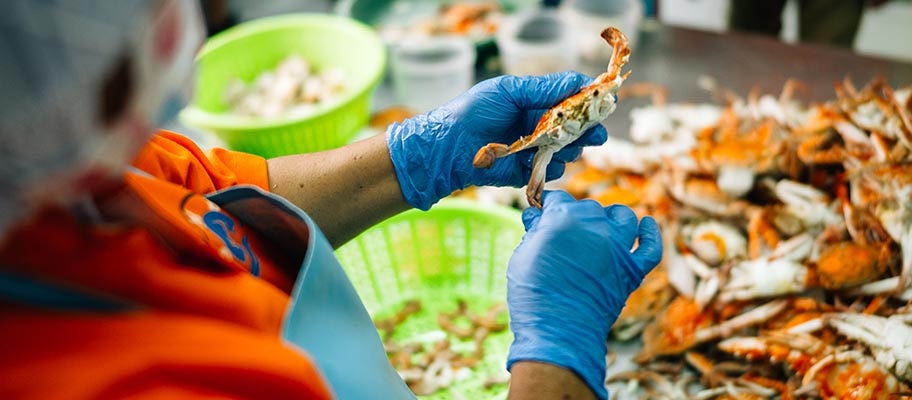
Picking meat from blue swimmer crabs in Indonesia. © Fostive Visual, Felix Sugianto
Crab types
There are several thousand known types of crab worldwide. Each of the edible varieties has its own physical characteristics and flavour profile. The Louisiana blue is prized for its sweet tasting meat; the mighty red king crab – known collectively as ‘Stalin’s Red Army’ in Norway – can have a 28cm carapace and up to a 1.8m leg span, and the brown crab is the largest swimming crab in British coastal waters, its name coming from the short hairs which coat its body.
Broadly speaking, coldwater crab is usually frozen then defrosted at home, while warmwater crab is picked and sold in tubs. “Coldwater crab has seen an increase in at-home sales during the pandemic because of the ease of picking up frozen crab legs, cooking them at home and having an easy, nutritious and delicious meal,” says Hawk. “Picked warmwater crab is also popular; sold in tubs, it is used in crab cakes, omelettes, salads, or in any dishes where you can just sprinkle on crab."
Crab Cakes & Lemon Mayo | Bart van Olphen
Which parts of crab can you eat?
There are two types of crab meat: soft brown and flaky white. The former is easier to access and scoop out, while the latter has to be artfully teased out of the claws and knuckles and is sold at a premium. You should discard the inedible gills, commonly known as ‘dead man’s fingers’.
The darker meat is like ‘seaside in a shell’, it has an intense, briny-sweet flavour and a grittiness on the palate; the white meat often has a sweeter, more delicate taste. Both white and brown meats welcome simple fresh ingredients such as crème fraîche, chives and lemon, which help to amplify their flavour. Many chefs find crab to be more versatile and less chewy than lobster, not to mention more affordable.
Charlotte Langley, a seafood chef and MSC Ambassador from the east coast of Canada, enjoys cooking with both types of crab meat: “I keep it simple with the white meat to make the most of its luscious bite. Whereas I love to fold the darker meat into a rich seafood stew or a salad with jicama (a Mexican root vegetable), jalapeno and some creme fraiche and melon.”
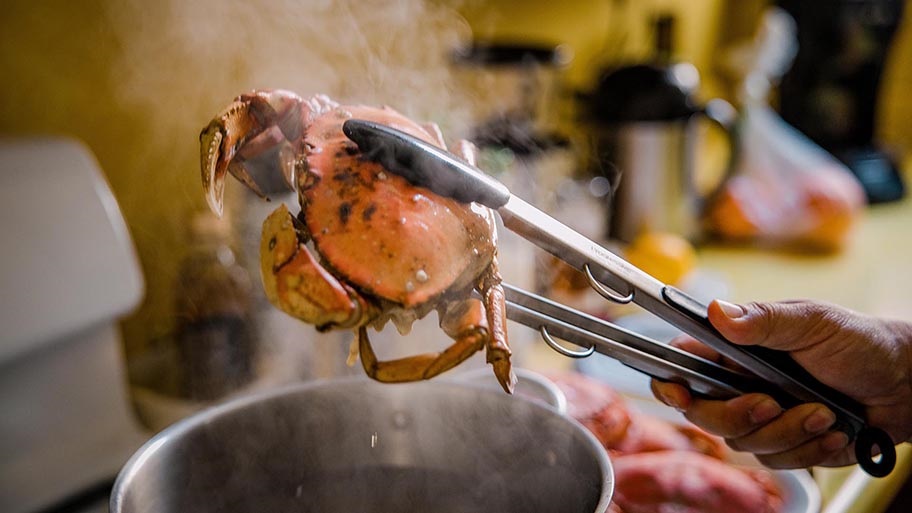
© Jason Leung/Unsplash
How to buy and prepare crab
Crab can be bought as a whole crab, crab legs (pre-cooked and usually frozen), or just the crab meat. If you are buying whole cooked crab and don’t want to prepare it yourself, ask your fishmonger to do all the fiddly prep. Coldwater crabs such as snow, Alaska red king or stone crab, prized for their subtle, sweet flavour and meaty legs, tend to be the most expensive.
From a cook’s perspective, different types and sizes of crabs respond best to different cooking methods. Oven cooked gives you a nice crispness outside and seals in the moisture nicely, while still giving you the full flavor of the crabmeat. I prefer to cook crab on the barbecue to add that irresistible smoky flavour. Soft-shell blue crabs are almost completely edible – shell and all – fried in a light Bayou blend batter as a summertime snack.
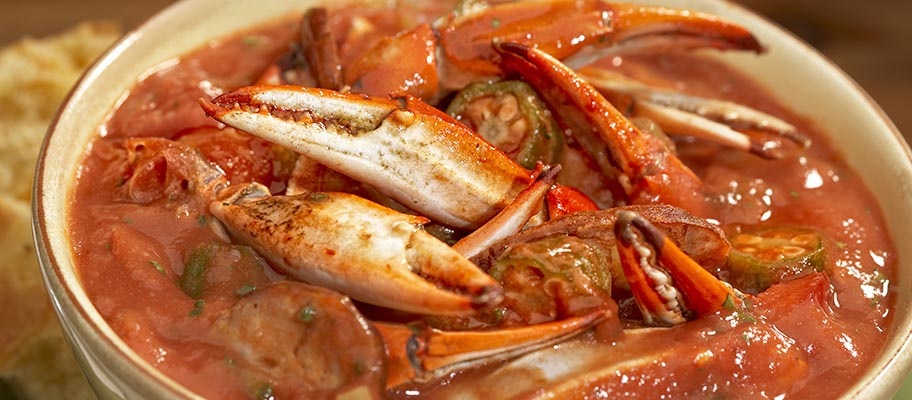
Louisiana blue crab dish © Emily Tripp
The best crab dishes
Crab might be a hard-shelled crustacean but it offers a lovely variety of dishes. At seaside cafes and shellfish stalls in Britain, crab is still rather quaintly served dressed in the shell filled with half brown and half white meat. Across the Pond, a ‘smash and crab’ feast in Maryland, a mid-Atlantic state in America, is a more raucous, finger licking affair. Typically, a table is lined with butcher paper and piled high with hot broiled crabs ready for diners clad in disposable bibs to assault with hammers and picks.
Mitch Tonks, chef, restaurateur and MSC Ambassador in the UK, is a big fan of both. Freshly dressed crab is a real crowd pleaser at his Rockfish restaurants in Devon where “the freshness and simplicity is fundamental”, but he also enjoys the reward of a backyard boil’s ‘treasure hunt’ armed with crab crackers and rolling pin at his kitchen table covered in newspaper. He adds: “You can taste the sea in freshly landed crab. Some good bread and mayo is all that is needed, or stir into pasta with chilli, olive oil and parsley.”
Fisherman Damien Bell of BellBuoy Seafoods also likes to keep it simple with warm, freshly peeled MSC certified blue swimmer crabs. “Our ‘Blueys’ are so delicate and sweet and so good that all they need is crusty bread with butter and white pepper. Or I like to use home-made garlic bread to soak up the wok juices from a chilli crab dish.”
“People love crab!” says Charlotte Langley. “Its sweet, sweet flavour and perfectly tender texture pairs well with most things: a zingy baked dip loaded with fresh dill and citrus, straight out of the shell and dipped in melted butter, or crispy crab cakes loaded with gribiche (a cold egg sauce with capers and herbs).”
Crab cakes, of course, are the king of the fishcake family. They can be made with either fresh crab or canned crab. In the US, jumbo lump crab is preferred, the large pieces of meat from the muscle that connects the crab’s powerful back swimming legs. Those chefs who plump for grilling or oven cooking say it enhances any seasoning (typically, old bay), while deep frying delivers a golden coat of crunchy breadcrumbs and keeps the inside creamy. Whichever way you choose, serve with pickled limes, toasted sweetcorn salsa or sweet chilli jam.
Other classic crab dishes include Singapore chilli crab (stir fried then simmered in a hot sauce made from shallots, ginger, red chillies, garlic, ketchup, and shrimp paste), a thick and creamy corn and crab chowder (add ginger, coconut cream and Thai fish sauce for an Asian take), and variations on a crab sandwich or roll – try crab brioche with lemon, mayo, capers and rocket.
Destined for the deep fryer are blue crab beignets with minced shallot and crème fraîche, and Chinese crabmeat and mushroom dumplings – both of which offer crunchy forkfuls of umami joy.
For cooler dishes try shredded white crabmeat served in the centre of gazpacho, homemade California rolls with rock crab and wasabi, or alioli avocado crab boats.
“It’s hard to overstate how wonderful it is to sit at the coast and enjoy a plate of fresh crabmeat from our seas,” says Mitch Tonks. “The demand for it probably drifted away a bit back in the 1980s when the prawn sandwich took over, but thankfully it’s made a comeback. I think partly it’s people recognising and thinking about the provenance of what they eat, and crab is a speciality in the UK and the world over.”
Foodie's guides to sustainable fish and seafood
Our in-depth guides on the best ways to cook popular species like tuna, salmon, hake and more...

